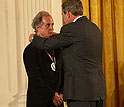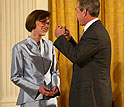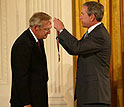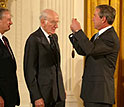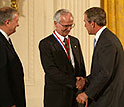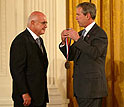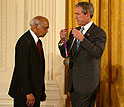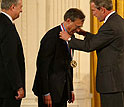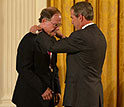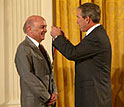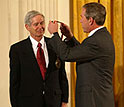Fact Sheet
Vital Information: Awardees of the 2001 National Medal of Science
May 21, 2002
This material is available primarily for archival purposes. Telephone numbers or other contact information may be out of date; please see current contact information at media contacts.
Biological Sciences
| Chemistry | Mathematics
| Behavioral and Social Sciences
| Engineering | Physical
Sciences
Who: Francisco J. Ayala, Donald Bren Professor of Biological Sciences,University of California, Irvine.
What: Ayala has revolutionized evolution theory by pioneering molecular biology in the investigation of evolutionary processes. His research has led to a new understanding of the origin of species, the pervasiveness of genetic diversity, the genetic structure of populations and rates of evolution among other concepts.
Ayala's biological discoveries have opened up new approaches to the prevention and treatment of diseases that affect hundreds of millions of individuals worldwide. He demonstrated that the reproduction of Trypanosoma cruzi, the agent of Chagas disease, is prevailingly clonal , and that only a few clones account for most of this widespread, mostly untreatable South American disease that affects 16-18 million people, and opened new approaches for the development of drug therapies and vaccines for combating the disease.
Recently, Ayala reconstructed the evolution of the four Plasmodium species that cause human malaria, and discovered that three of them were originally parasitic to other species, from which they were transmitted to humans. P. falciparum causes malignant malaria, a disease that debilitates several hundred million people and kills more than one million children each year. Ayala and his collaborators have shown that they all derive from one single African strain that lived about 5,000 years ago, and that worldwide falciparum parasites are genetically uniform in all protein-coding genes, except for the few genes that have recently evolved in response to the human immune system or to drug therapies. The public health consequences of this discovery are beginning to be appreciated, and are potentially enormous.
Personal: Ph.D., Columbia University. Born in Madrid, Spain, Mar. 12, 1934.
Public Information Contact: Tom Vasich, University of California, Irvine Voice - (949) 824-6925. Fax - (949) 824-8673. E-mail - tmvasich@uci.edu
Who: Mario R. Capecchi, Distinguished Professor of Human Genetics, University of Utah School of Medicine, and Investigator, Howard Hughes Medical Institute
What: Capecchi's investigations have revolutionized biomedical research and provided a powerful tool for understanding disease mechanisms and gene functions. Capecchi's gene knockout technology has revolutionized mouse genetics, with vast implications for human biology and medicine. This technology is being used to determine the function of genes in all mammalian biological phenomena from embryogenesis to brain function, and to generate mouse models for human genetic diseases.
At a time when scientists believed that targeted gene disruption, which depends on the mechanism of homologous recombination, could not be achieved in animal cells, Capecchi pioneered gene targeting by gaining a detailed understanding of how DNA sequences of a resident gene were exactly replaced by the introduced gene sequence. Countless laboratories worldwide now use this technology to investigate human disease and to systematically dissect the function of individual genes.
Personal: Ph.D. in biophysics, Harvard University. Born in Verona, Italy, Oct. 6, 1937.
Public Information Contact: Kristen Kamerath, University of Utah Department of Human Genetics Voice - 801-585-0538. Fax - 801-585-9557. E-mail - Kristen.kamerath@genetics.utah.edu
Who: Ann M. Graybiel, Walter A. Rosenblith Professor of Neuroscience, Massachusetts Institute of Technology.
What: Graybiel has revolutionized our understanding of the functional anatomy and physiology of the brain. She and her group made the pioneering discovery of the fundamental architecture of the large forebrain region known as the basal ganglia, and demonstrated a mechanism of directed neurochemical control of complex brain circuits. Her work provides an understanding of how activity states of the forebrain are controlled and modulated during motor activity, procedural learning and cognition. The work has major clinical relevance for disorders such as Parkinson's and Huntington's diseases; for neuro- psychiatric disorders such as Tourette syndrome, obsessive compulsive disorder, attention deficit disorder, and major depression. Graybiel's work directly addresses the issue of how humans can make and break habits, an issue of fundamental importance in human behavior.
In her more recent studies, Graybiel has discovered that the long-term changes in gene expression patterns in the basal ganglia are predictive of the development of behavioral stereotypes in the treated animals. At the same time, they are tracking the changes in neuro signaling occurring behavioral learning. This work represents a breakthrough in bringing together the seemingly separate fields of gene regulation, neurophysiology and behavioral observation.
Personal: Ph.D., Massachusetts Institute of Technology. Born in Chestnut Hill, Mass., Jan. 25, 1942.
Public Information Contact: Deborah Halber, Massachusetts Institute of Technology Voice - 617-258-9276. Fax - 617-258-8762. E-mail - dhalber@mit.edu
Who: Gene E. Likens, Director and President and G. Evelyn Hutchinson Chair in Ecology, Institute of Ecosystem Studies, Millbrook, New York
What: Likens, with colleagues, was the first to document the link between the increasing acidity of precipitation and fossil fuel combustion in North America, and the long-term consequences of this phenomenon - acid rain. His findings catalyzed a vigorous public policy dialogue, stimulated new scientific studies, and raised awareness of the connections between human activities and the ecosystems upon which humans are dependent. His work and the attention it commanded led to national legislation addressing the effects of acid rain.
Likens' classic long-term ecological studies led to important insights regarding the concept of the critical linkages among an ecosystem, an airshed, a watershed, nutrient cycling, effects of land-use practices, biogeochemical cycles and the role of riparian zones. His approach is now the guiding paradigm in the science of ecology and in the application of this science to finding solutions for global environmental problems, including deforestation, the greenhouse effect, acid rain, and eutrophication.
Personal: Ph.D. in zoology, University of Wisconsin, Madison. Born in Pierceton, Ind., Jan. 6, 1935.
Public Information Contact: Joseph S. Warner, Institute of Ecosystem Studies Voice - 845-677-5343. Fax - 845-677-5976. E-mail - warnerj@ecostudies.org
Who: Victor A. McKusick, University Professor of Medical Genetics, Professor of Biology, Professor of Epidemiology, and Professor of Medicine, Johns Hopkins University School of Medicine
What: McKusick is largely responsible for bringing genetics into the mainstream of clinical medicine. As the founding father of modern medical genetics, Dr. McKusick demonstrated the value of careful observation of patients with inherited disorders, in which he provided a framework for basic scientists in search of biochemical and molecular defects.
In 1966 he organized the knowledge base in human genetics into an encyclopedic reference, Mendelian Inheritance in Man, which has provided the foundation for the human genome project and human gene mapping.
McKusick was the first to point out publicly the potential power inherent in the complete DNA sequencing and characterization of the human genome. He urged the organization of the Human Genome Project even when the technologies were barely capable of addressing such a challenge. The recent completion of the human genome sequence is a testimony to his influence in initiating the project.
Personal: M.D., Johns Hopkins University School of Medicine. Born Parkman, Maine, Oct. 21, 1921.
Public Information Contact: Joann Rodgers, Johns Hopkins University School of Medicine and The Johns Hopkins Hospital. Voice - 410-955-8659. Fax - 410-955-8255. E-mail - jrodgers@jhmi.edu
Who: Harold Varmus, President, Memorial Sloan-Kettering Cancer Center
What: Varmus is best known for pioneering studies of animal retroviruses, in which he and J. Michael Bishop discovered that normal human and animal cells contain genes capable of becoming cancer genes. This discovery was a revolutionary finding that inaugurated a new era in cancer research and ignited a spectacularly successful search for the genetic origins of cancer. To date, scientists have identified more than 100 genes that cause cancer in humans. Varmus and Bishop received the 1989 Nobel Prize in Physiology or Medicine for their work.
During a highly praised tenure as director of the National Institutes of Health from 1993-1999, Varmus initiated many changes in the conduct of intramural and extramural research programs, recruited outstanding new leaders for many of the institutes, and helped to increase the agency's annual budget from under $11 billion to nearly $18 billion.
Varmus has co-authored more than 300 scientific papers and four books, including an introduction to the genetic basis of cancer for a general audience.
Personal: M.D., Columbia University. Born in Oceanside, N.Y., Dec. 18, 1939.
Public Information Contact: Christine Hickey, Memorial Sloan Kettering Cancer Center, Voice - 2l2-639-3627. Fax 212-639-3527. E-mail - hickey1@mskcc.org
Who: Ernest R. Davidson, Distinguished Professor and the Robert and Marjory Mann Chair in Computational Quantum Chemistry, Indiana University
What: Davidson has changed our understanding of the nature of matter. His numerous conceptual and algorithmic developments led to the field of computational quantum chemistry and made possible the accurate modeling of chemical reactions and the response of molecules to radiation.
Davidson invented the iterative natural orbital method, which led to some of the earliest accurate wave functions. He also developed the Davidson correction for improving calculated energies. He was a world leader in the theory of reduced density matrices and their application to chemistry. No other quantum chemist has shown this diversity of important developments.
Davidson entered the field of computers and was one of the first to turn from preconceived models and focus on letting the computer determine the answer, a radical change in philosophy at the time. A large number of conceptual and algorithmic advances bear his name. The most widely used is the purely mathematical advance called the Davidson method, which stimulated developments in applied mathematics and led to applications in physics and engineering unconnected to quantum chemistry.
Personal: Ph.D. in chemistry, Indiana University. Born in Terre Haute, Ind., Oct. 12, 1936.
Public Information Contact: David Bricker, Indiana University Voice - 812-856-9035. Fax - 812-855-7002. E-mail - brickerd@indiana.edu
Who: Gabor A. Somorjai, Professor of Chemistry, University of California, Berkeley, and Faculty Senior Scientist, Lawrence Berkeley National Laboratory.
What: Somorjai is the world leader in developing modern surface science. He established the molecular foundation of many surface-based technologies. His fundamental surface studies over the past 35 years contributed the lion's share of molecular level understanding of surface structure, the bonding of adsorbates and the concepts and ingredients responsible for the reactivity of surfaces that helped the development of surface technologies.
Somorjai began the process of discovering the fundamental bases of heterogeneous catalysis, without which the chemical industry as we know it today would not exist. His techniques and the results he obtained bear on many surface features of broad technical importance such as adhesion, lubrication, friction, absorption catalysis and other phenomena that depend on surface interactions.
Personal: Ph.D. in chemistry from the University of California at Berkeley. Born in Budapest, Hungary, May 4, 1935.
Public Information Contacts: Robert Sanders,
University of California at Berkeley Voice - 510-643-6998.
Fax - 510-642-7289. E-mail - rls@pa.urel.berkeley.edu
Lynn Yarris, Lawrence Berkeley National Lab Voice
- 510-486-5375. Fax 510-486-6641. E-mail: lcyarris@lbl.gov
Who: Calyampudi R. Rao, Emeritus Holder of the Eberly Family Chair in Statistics, and Director of the Center for Multivariate Analysis, Pennsylvania State University and Adjunct Professor, University of Pittsburgh.
What: Rao's pioneering work in multivariate analysis has become the foundation of statistics, with a significant impact on applications in medical diagnosis, evolutionary genetics, and signal detection theory.
Rao has focused equally on the application of statistical methods to real-world problems. One of his early books, Advanced Statistical Methods in Biometric Research (1952), was written to assist biomedical researchers who were not equipped to develop the new methods of analysis their data demanded.
In response to the needs of industry, he introduced a new method of experimentation through combinatorial arrangements, known as Orthogonal Arrays, which has become widely used to control and improve the quality of manufactured goods. He developed estimation theory in small samples, which greatly extended the scope of statistical methods in practical work.
Rao was the first to introduce differential geometric techniques in discussing problems of statistical inference, based on Rao's Distance Function, which is now an active field of research.
Personal: Ph.D., Cambridge, U.K. Born in Hadagali, India, Sept. 10, 1920.
Public Information Contacts: Leta Krumrine,
Penn State University Voice - 814-863-8453. Fax -
814-863-2246. E-mail - lak15@psu.edu
John Fedele, University of Pittsburgh Voice - 412-624-4148.
Fax - 412-624-4895. E-mail - jfedele@pitt.edu
Who: Elias M. Stein, Albert Baldwin Dodd Professor of Mathematics, Princeton University.
What: Stein has influenced the shaping of the field of mathematical analysis and has changed the way mathematicians approach problems in nearly every subarea of the field. He was among the first to appreciate the interplay among partial differential equations, classical Fourier analysis, several complex variables and representation theory. He was the first to perceive the fundamental insights in each field arising from that interplay.
Stein is the world's leading authority in harmonic analysis. Stein and colleagues introduced a generalization of analytic functions in higher dimensions known as Hp-spaces. This theory led to important connections between harmonic analysis and probability theory, and facilitated the solution of numerous problems. In his studies, he also showed the power of using square functions to control error terms, a technique that he invented and that is now fundamental in harmonic analysis.
Personal: Ph.D., University of Chicago. Born in Belgium, Jan. 13, 1931.
Public Information Contact: Steven Schultz, Princeton University Voice - 609-258-5729. Fax - 609-258-1301. E-mail - sschultz@princeton.edu
Behavioral and Social Sciences
Who: George F. Bass, George T. and Distinguished Professor Emeritus of Nautical Archaeology, Texas A&M University and Founder, Institute of Nautical Archaeology
What: Bass is recognized as the father of nautical archaeology after directing and publishing the first complete excavation of an ancient shipwreck four decades ago. His research has made unique contributions to the sociology of ancient seafaring from the Bronze Age to the Classical, Byzantine and Islamic eras and by tracing the evolution of the watercraft on which the world depended for millennia.
Bass founded the Institute of Nautical Archaeology which has conducted some of the most important excavations of the twentieth century, and its findings throw new light into areas as diverse as the beginning of the free enterprise system, the dating of Homer's Odyssey, chronologies of Egyptian dynasties and Helladic cultures, and the histories of technology, economics, music, art and religion.
His team was the first to locate an ancient shipwreck with sonar, and Bass, with his colleagues, introduced a submersible decompression chamber and the routine breathing of pure oxygen during decompression after dives, now a standard procedure worldwide. Bass also has dedicated an enormous amount of thought and planning to the conservation of cultural remains raised from the sea bed.
Personal: Ph.D., University of Pennsylvania, in Classical Archaeology. Born in Columbia, S.C., Dec. 9, 1932.
Public Information Contact: Ryan Garcia, Texas A and M University Voice - 979-845-4680. Fax 979-845-6745. E-mail - rag@univrel.tamu.edu
Who: Andreas Acrivos, Albert Einstein Professor of Science and Engineering, City College of the City University of New York, and Professor of Chemical Engineering, Emeritus, Stanford University
What: Acrivos is widely recognized for his contributions to the modern theory of fluid mechanics and convective heat and mass transfer.
Several of his pioneering studies created new fields. He was one of the first to develop and use what is known as the boundary-integral method for numerically solving the partial differential equations of linear hydrodynamics. He helped to establish the scientific basis for the field of suspension mechanics, and his work was highly relevant to industries ranging from oil production to the manufacture of semiconductors. Acrivos showed that the powerful techniques of asymptotic analysis and computational fluid dynamics could be applied successfully to explain and predict suspension behavior.
Acrivos has also mentored several generations of graduate students and influenced other researchers who have made major contributions to their fields.
Personal: Ph.D. in chemical engineering, University of Minnesota. Born in Athens, Greece, Jun. 13, 1928.
Public Information Contact: Charles DeCicco, City College of the City University of New York Voice - 212-650-5310. Fax - 212-650-7584. E-mail - cdecicco@ccny.cuny.edu
Who: Marvin L. Cohen, University Professor, Department of Physics, University of California, Berkeley and Lawrence Berkeley National Lab
What: Cohen created, developed, and applied a theory of real materials based on quantum mechanics at the atomic level. His plane wave pseudopotential method provided an understanding of materials in general and semiconductors in particular, which has transformed technology.
He established the foundations of the major techniques used worldwide for computing properties of solids. He has an unparalleled record of explaining and predicting properties of matter. Examples of his successful predictions are the first superconducting oxide (semiconducting) material, a host of new structural phases of solids, several new superconductors including silicon at high pressures, new compound nanotubes, and new classes of superhard solids.
During the past 35 years, there has been a revolution in the use of quantum theory to predict the existence of new materials and properties, and Dr. Cohen is the individual most responsible for this advance. He correctly predicted the existence of new materials and explained many properties of solids.
Personal: Ph.D., University of Chicago. Born in Montreal, Quebec, Canada, Mar. 3, 1935.
Public Information Contacts: Robert Sanders,
University of California at Berkeley Voice - 510-643-6998.
Fax - 510-642-7289. E-mail - rls@pa.urel.berkeley.edu
Lynn Yarris, Lawrence Berkeley National Lab Voice
- 510-486-5375. Fax 510-486-6641. E-mail: lcyarris@lbl.gov
Who: Raymond Davis, Jr., Research Professor of Physics and Astronomy, University of Pennsylvania and Guest Collaborator, Brookhaven National Laboratory
What: In the 1960s, Davis was the first scientist to measure the flux of neutrinos from the sun, the signature of nuclear fusion reactions occurring in the core of the sun. Using chlorine detectors, Davis found only one-third of the neutrinos that standard theories predicted -- the "solar neutrino problem" -- and for the next 20 years, physicists focused on resolving that discrepancy. Experiments in the 1990s using different detectors eventually confirmed the neutrino discrepancy. The lower than expected event rates are now accepted worldwide as evidence for neutrino oscillations.
He contributed to geochemical methods of geological dating of surface rocks and applied this technique to meteorites and lunar rock samples returned to earth. He also applied the technique to measure the radioactivity of spy satellites.
Personal: Ph.D. in chemistry, Yale University. Born in Washington, D.C., Oct. 14, 1914.
Public Information Contact: Mona Rowe, Brookhaven National Laboratory Voice - 631-344-5056. Fax - 631-344-3368. E-mail - mrowe@bnl.gov
Who: Charles D. Keeling, Professor of Oceanography and Research Oceanographer, Scripps Institution of Oceanography, San Diego, California
What: Keeling has been a pioneer and leader in the study of the global carbon cycle, its responses to change through the combustion of fossil fuels and changes in land use, and the complex relationships between the carbon cycle and changes in climate. In the process, he has collected what many believe to be the most important time series data set for the study of global change, the record of the global increase in atmospheric carbon dioxide measured at Mauna Loa, Hawaii, and at other "clean air" locations, including the South Pole. The Mauna Loa record is known as the Keeling Curve.
Keeling has been a leader in the study of the role of oceans in modulating the atmospheric concentration of carbon dioxide and in carrying out the extremely accurate measurements of the dissolved carbonate system in seawater that are required to address this problem. He became the first to determine definitively the fraction of CO2 from combustion that is accumulating in the atmosphere.
Keeling and his colleagues have also undertaken major efforts in global carbon cycles modeling. Keeling has shown that the amplitude of the Northern Hemispheric seasonal cycles in atmospheric carbon dioxide has been increasing, providing independent support for the conclusion that the growing season is beginning earlier, perhaps in response to global warming.
Personal: Ph.D., Northwestern University, Evanston, Ill. Born in Scranton, Penn.
Public Information Contact: Cindy Clark, Scripps Institution of Oceanography Voice - 858-534-3624. Fax - 858/534-5306. E-mail - cclark@ucsd.edu
-NSF-
-
Francisco Ayala receives the Medal of Science from President Bush.
Credit and Larger Version -
Mario Capecchi receives the Medal of Science from President Bush.
Credit and Larger Version -
Ann Graybiel receives the Medal of Science from President Bush.
Credit and Larger Version -
Gene Likens receives the Medal of Science from President Bush.
Credit and Larger Version -
Victor McKusick receives the Medal of Science from President Bush.
Credit and Larger Version -
Harold Varmus receives the Medal of Science from President Bush.
Credit and Larger Version -
Ernest Davidson receives the Medal of Science from President Bush.
Credit and Larger Version -
Gabor Somorjai receives the Medal of Science from President Bush.
Credit and Larger Version -
Calyampudi Rao receives the Medal of Science from President Bush.
Credit and Larger Version -
Elias Stein receives the Medal of Science from President Bush.
Credit and Larger Version -
George Bass receives the Medal of Science from President Bush.
Credit and Larger Version -
Andreas Acrivos receives the Medal of Science from President Bush.
Credit and Larger Version -
Marvin Cohen receives the Medal of Science from President Bush.
Credit and Larger Version -
Raymond Davis, Jr. receives the Medal of Science from President Bush.
Credit and Larger Version -
Charles Keeling receives the Medal of Science from President Bush.
Credit and Larger Version
See also:
For more information on National Medal of Science, see: http://www.nsf.gov/nsb/awards/nms
For information on National Medals of Technology, see: http://www.ta.doc.gov/medal
Also see: http://www.nationalmedals.org
Media Contacts
William C. Noxon, NSF, (703) 292-8070, email: wnoxon@nsf.gov
Program Contacts
Susan E. Fannoney, NSF, (703) 292-4518, email: sfannon@nsf.gov
The U.S. National Science Foundation propels the nation forward by advancing fundamental research in all fields of science and engineering. NSF supports research and people by providing facilities, instruments and funding to support their ingenuity and sustain the U.S. as a global leader in research and innovation. With a fiscal year 2023 budget of $9.5 billion, NSF funds reach all 50 states through grants to nearly 2,000 colleges, universities and institutions. Each year, NSF receives more than 40,000 competitive proposals and makes about 11,000 new awards. Those awards include support for cooperative research with industry, Arctic and Antarctic research and operations, and U.S. participation in international scientific efforts.
Connect with us online
NSF website: nsf.gov
NSF News: nsf.gov/news
For News Media: nsf.gov/news/newsroom
Statistics: nsf.gov/statistics/
Awards database: nsf.gov/awardsearch/
Follow us on social
Twitter: twitter.com/NSF
Facebook: facebook.com/US.NSF
Instagram: instagram.com/nsfgov



